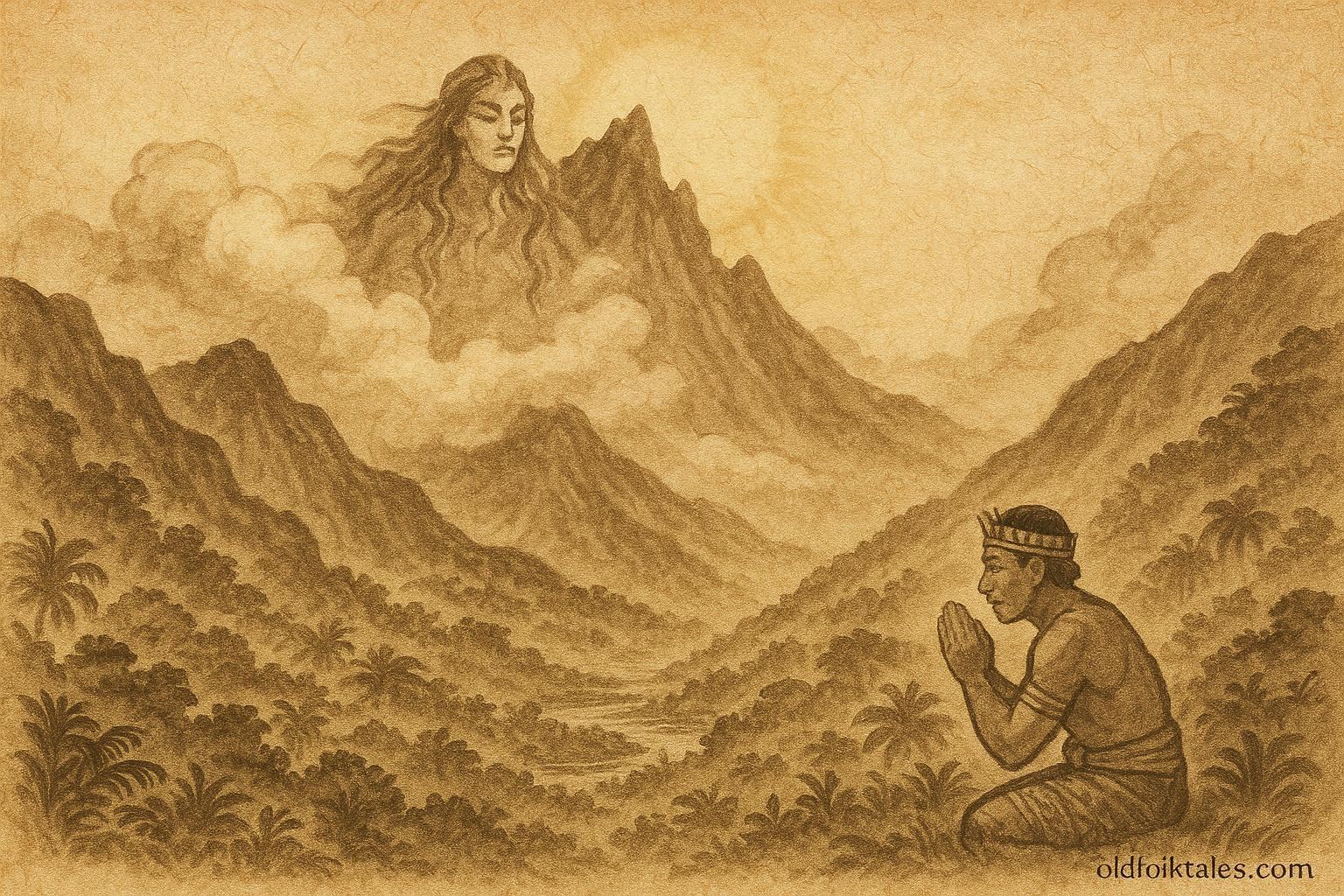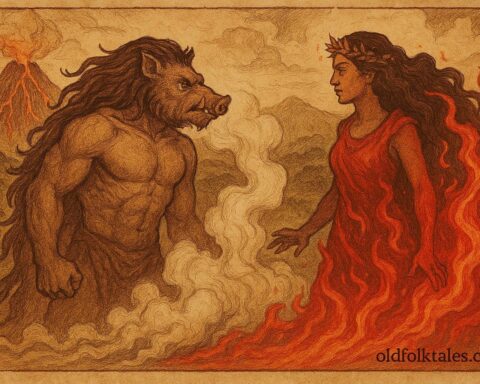In the heart of Tahiti, where emerald mountains rise from the sea like the backs of sleeping gods, stands the mighty Mount Orohena. Its peak pierces the clouds, draped in silver mist and kissed by the first light of dawn. The people of Tahiti have always revered Orohena as sacred, a living guardian whose breath stirs the winds and whose silence watches over the valleys below.
Long ago, before the time of foreign ships and distant bells, the mountain was known not merely as stone and soil, but as a spirit, a presence called Te Varua o Orohena, the Soul of the Mountain. The elders said that when the world was young, the gods appointed Orohena to be the heart of the island. From his summit, he looked down upon Tahiti and kept the balance between land, sea, and sky.
Discover how courage and cleverness shaped the storytelling traditions of Micronesia
When the people honored the land and gave thanks through song, the spirit of Orohena smiled. Gentle rains would fall upon the crops, and the rivers would flow clear and full. But when humans grew careless, when they cut too deeply into the forests or forgot their offerings to the spirits, Orohena stirred in sorrow. His sigh became thunder, and his tears fell as storms that swept through the valleys.
The Time of Forgetfulness
There came a generation when the people of Tahiti, prospering in abundance, began to forget the old ways. The forests were felled faster than they could grow, and the songs once sung at the new moon fell silent. The tohunga, the wise priests of the mountain, warned the chiefs:
“Do not take without giving, and do not walk upon the sacred slopes without prayer. For the guardian of Orohena sees all, and his patience is not eternal.”
But the chiefs laughed. “The mountain is old stone,” they said. “It does not feel nor hear.”
So they continued their feasts and took what they pleased, the wood for their canoes, the fruit from the sacred groves, the water from the hidden springs. The air grew heavy with neglect.
One morning, a thick darkness began to creep over the island. Clouds gathered so low that they swallowed the summit of Orohena. The winds turned cold and restless, whirling through the valleys like voices of anger. Soon the rain fell, not in gentle showers, but in violent torrents. Rivers overflowed, crops were swept away, and lightning struck the forests that once stood proud.
The people huddled in their huts, terrified, for they knew then that the spirit of Orohena had awakened.
The Chief’s Vision
For three days and nights, the storm raged. On the fourth night, an old chief named Tamae climbed the mountain alone, carrying an offering of breadfruit, flowers, and a conch shell. His people begged him not to go, but Tamae was wise and knew that only humility could calm the guardian’s wrath.
The climb was steep, and rain lashed against his face, but he pressed on, chanting the ancient prayer of peace. When he reached the high plateau beneath the peak, lightning split the clouds, revealing a vast light, a shape like a towering figure formed from mist and mountain stone. The Spirit of Orohena spoke, his voice deep as the earth:
“Why have your people forgotten the covenant of the land? I gave you rain, fruit, and fish. You answered with greed and silence. The balance has been broken.”
Tamae fell to his knees. “Great guardian,” he cried, “forgive us! The people have forgotten, but their hearts can still remember. Teach us again, and we will honor your gift.”
The spirit gazed down at him for a long while, and then the thunder softened. “If your hearts are true, the mountain will know it,” said Orohena. “Go. Restore harmony, and I shall clear the skies.”
With that, the winds began to quiet, and the clouds slowly drifted away from the summit. Tamae descended, carrying the message of the mountain.
Restoring Harmony
When he returned to the village, Tamae gathered everyone around the sacred marae, the stone temple at the foot of Orohena. He repeated the spirit’s warning and urged them to renew their prayers. The people, humbled by the storm, began to work together once more.
They replanted the groves they had destroyed and returned offerings to the streams and the sea. Fishermen took only what they needed, and children learned songs of gratitude to the mountain. The tohunga lit sacred fires once again, sending spirals of fragrant smoke toward the peak as a sign of peace.
Soon, the rains became gentle, nourishing the land instead of drowning it. The forests grew green, the rivers ran clear, and the summit of Orohena shone white and pure beneath the morning sun. The people rejoiced, for they knew the guardian spirit had forgiven them.
From that day on, no one climbed Mount Orohena without prayer. The elders taught that the mountain’s silence was sacred, a living reminder that the land and the people breathe as one. When clouds gather now over Tahiti, they say the guardian is watching, ensuring the balance between abundance and humility remains unbroken.
And when the skies clear after the rain, villagers lift their eyes to the mountain and whisper a quiet “mauruuru”, thank you, to the spirit who keeps the island alive.
Discover the adventures of Māui, Pele, and Tangaloa in the timeless Polynesian oral tradition
Moral Lesson
The Spirit of Mount Orohena teaches that harmony between people and nature depends on respect and gratitude. When humans forget their connection to the land, balance falters, but through humility and reverence, renewal is always possible.
Knowledge Check (Q&A)
- Who is the guardian spirit in The Spirit of Mount Orohena?
The spirit of Mount Orohena is a divine guardian who watches over Tahiti, maintaining balance between the land, sea, and sky. - What caused the storms to descend from Mount Orohena?
The people’s greed, neglect of prayers, and disrespect for nature angered the mountain spirit, bringing destructive storms. - How did the people restore harmony with the spirit?
Through humility, prayer, and renewing their respect for nature, by replanting forests and offering thanks to the gods. - What lesson does this Tahitian folktale teach?
It teaches stewardship of the earth, spiritual balance, and the belief that nature responds to human actions and intentions. - Why is Mount Orohena sacred in Tahitian mythology?
It symbolizes divine guardianship and the spiritual link between people and the natural world, the heart of the island itself. - What does the story reveal about Polynesian spirituality?
It reflects Polynesian beliefs in sacred ecology, that gods inhabit natural elements and human harmony ensures divine favor.
Source: Adapted from Ancient Tahiti by Teuira Henry (1928), derived from the Orsmond Manuscripts (19th-century oral traditions).
Cultural Origin: Tahitian (Society Islands, French Polynesia)












